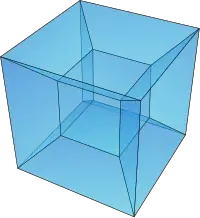My question is little bit philosophical. I would like to explain my ideas with a 2 dimensional universe model.
If we had lived in 2 dimensional universe like a plane, What could we observe when seeing a 3d object?
For example: If a square pyramid that is inside full of material comes to the plane universe in right angle, what could the people who live in 2d universe observe? Firstly, we could see small square and slowly it would enlarge and then it would dissappear suddenly. If the scientists who live in the 2d universe observed such event , All scientists could get shocked and they could check their physics formulas because energy is not conversed in that event. They had believed that Energy is conserved and nobody could create energy from nothing and finally they could understand that total observed universe energy can be much more what they calculated with their formulas.
My questions:
What could we see a 4d pyramid comes to our 3d universe? is it correct that Firstly we would see small cube and it would enlarge and then suddenly disappears?
Dark matter and Dark energy is related with such ideas? http://map.gsfc.nasa.gov/universe/uni_matter.html
I know we do not observe such strange events till now but maybe scientists can get some results during micro experiments. Is there any such experimental results at least in micro universe (atomic level experiments in quantum mechanics)?
Sorry for your time if it was asked before.
